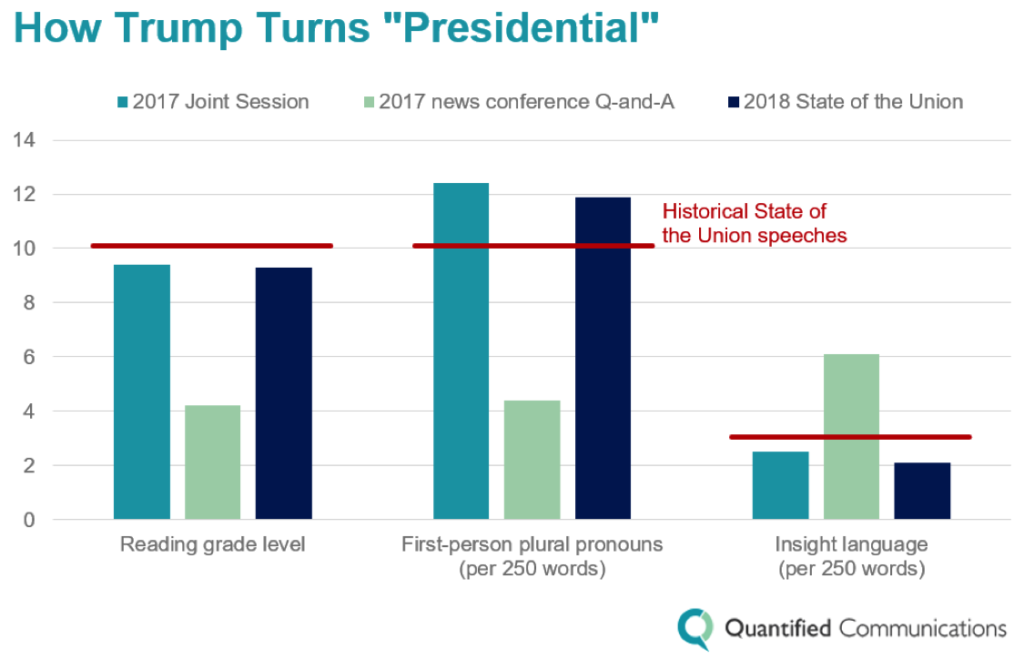The Three Strategies Trump Used to Sound “Presidential” in His First State of the Union

The reviews of President Donald Trump’s first State of the Union revolved around one word, but it wasn’t a word in the speech. From the fawning praise of Republican message guru Frank Luntz – “The presidential performance that Trump observers have been waiting for” – to the wary acknowledgement of the USA Today editorial board – “’Presidential’ Trump, a one-night wonder?” – the word was “presidential.”
“Tone does matter,” as then-candidate Trump acknowledged in an April 2016 town hall with Fox News. “I will be so presidential,” he nonetheless promised in that 2016 interview. “Being presidential is easy.”
Quantified Communications compared State of the Unions from every president since John F. Kennedy with another set of speeches by prominent people on the biggest stage of their lives: TED Talks. The analysis revealed three big differences.
In particular, sounding presidential is about three elements of tone – complexity, inclusiveness, and certainty – that distinguish presidents from other high-profile speakers, and that don’t come naturally to Trump.
First, presidents speak with more complexity than TED presenters. The readability of State of the Union speeches, measured by the length of words and sentences, clocks in at a tenth-grade level, which is relatively high for spoken English. Second, inclusivity reigns on the Capitol Hill dais, where pronouns like “we” and “us” appear twice as often as on the TED stage. Third, State of the Union speeches are delivered with more certainty than TED Talks, employing 44 percent fewer of the words that we use to describe our own thought processes, like “think” and “know” – language scientists call this category of words “insight language.”

Trump’s language, when he’s speaking without a script, bears the exact opposite distinguishing characteristics. It’s unusually simple, overwhelmingly self-focused, and, beneath a veneer of certainty, richly planted with hedges like “I guess” and “I would say.” Take this moment from Trump’s only solo news conference as president, an event that a chorus of critics called “unpresidential,” on February 16, 2017:
Well, I guess one of the reasons I’m here today is to tell you the whole Russian thing, that’s a ruse. That’s a ruse. And by the way, it would be great if we could get along with Russia, just so you understand that. Now, tomorrow you’ll say, Donald Trump wants to get along with Russia; this is terrible. It’s not terrible; it’s good.
The shortest sentence spans three little words, “I” outnumbers “we” two-to-one, and the screed starts with the introspective “I guess.” This is Trump’s natural state, but not his permanent one. When a moment like Tuesday’s State of the Union calls for more presidential language, Trump delivers complexity, inclusiveness, and certainty closer to historic norms.

Trump pulled the same trick in his 2017 speech to a Joint Session of Congress. The language matched historic presidential norms, even if the ideas – like the Office of Victims of Immigrant Crime Engagement – were unprecedented. Style beat substance, as even CNN commentator Van Jones, a committed Trump adversary, declared of the speech, “He became president in that moment.”
On Tuesday night, Jones was less charitable, calling Trump’s speech “sweet-tasting candy with poison in it.” Other critics have also gotten wise to the act. “Please don’t call him presidential,” asked Michelle Goldberg in the New York Times, a full day before the State of the Union.
“Teleprompter Trump” and “Trump Being Trump” are two dramatically different speakers. But if there’s one constant between the two of them, it’s that the former reality TV star knows how to put on a show. ■
Adam Tiouririne of Logos Consulting Group advises senior business leaders on high-stakes communication and served as the language analyst for Bloomberg Politics coverage of the 2016 election.